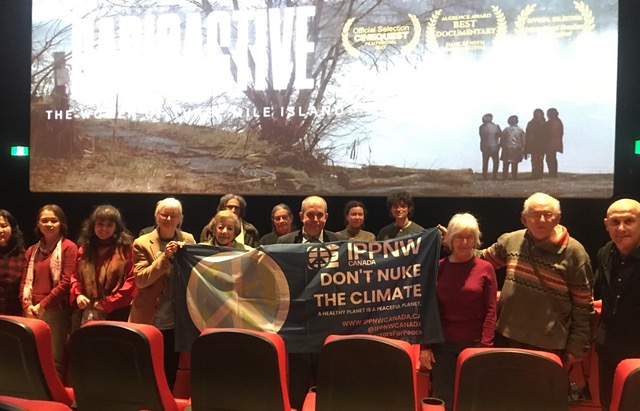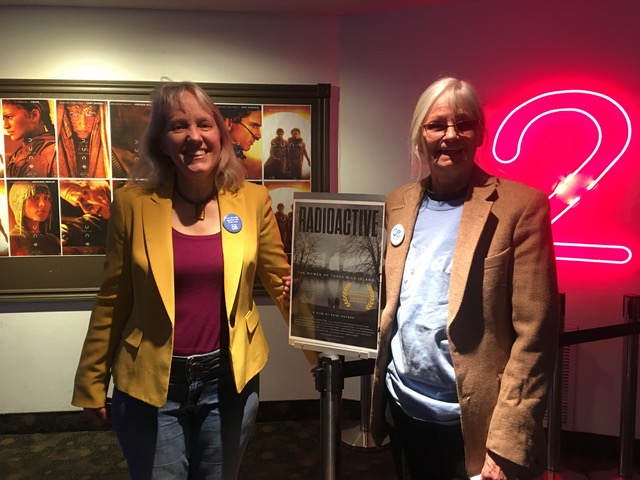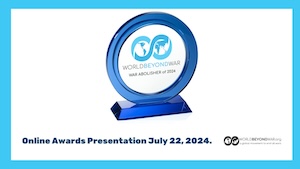
By Cym Gomery, Coordinator of Montreal for a World BEYOND War, April 4, 2024
On March 28, 2024, 45 years after the Three Mile Island nuclear accident, Montreal for a World BEYOND War and the Canadian Coalition for Nuclear Responsibility hosted the screening of a new documentary, Radioactive: The Women of Three Mile Island.
The Three Mile Island accident was a nuclear meltdown of Reactor number 2 in 1979 near Harrisburg, Pennsylvania. It is the worst commercial nuclear power accident in U.S. history, and, in opinion of Lynne Bernabei, a litigator who defended the community in the wake of the accident, “one of the biggest cover-ups in history.”
The filmmaker, Heidi Hutner, travelled to Pennsylvania 45 years after the Three Mile Island accident in order to interview members of the affected communities and discern what really happened. She ended up centering her narrative on four unlikely heroes–mothers-turned-activists who refused to “go home and bake cookies” as one person mockingly advised—and instead asked discomfiting questions of politicians, picketed against the re opening of Reactor number 1, and hired lawyers to sue the nuclear power company, Metropolitan Edison, for damages.
Radioactive is a documentary that makes demands on the audience, in that it does not tell us what to think. This is an understated film in which the filmmaker’s face is a study of empathy as she interviews the people of Three Mile Island. Hutner allows her video camera to linger on the faces of the victims, on the pauses between their testimony that speak volumes, and on aerial views of the bucolic countryside surrounding the nuclear facility, verdant and innocent like a sacrificial victim. It is interesting that those defending the nuclear industry are all men, and that the mothers, the anti-nuclear activists (Jane Fonda, Helen Caldicott for example) and even the two lawyers who continue to probe for truth and justice in this matter are women, and this in 1979, at a time when women identified more often as housewives than as wage earners.
There are several disquieting aspects of this case:
- The newspapers widely reported that there was no danger to the population from the meltdown—but based on reassurances from the industry and not on actual data. The instruments that were supposed to measure radioactivity in the reactor were jammed during the accident.
- The legal proceedings about whether to reopen the reactor revealed a number of coverups and shoddy practices, but as the evidence accumulated, the proceedings were abruptly shut down. Shortly after, the reactor was reopened anyway.
- The anecdotal evidence of farm animal miscarriages and deaths, the cancers and untimely deaths of many residents of communities near TMI, and other unexpected deaths were all brushed aside by industry officials and local politicians.
This film stayed with me, and I felt that one of the poignant and puzzling aspects of the people in rural farming communities near TMI was their overall attitude of resignation in the face of all these injustices. This is especially striking in the interview with the husband of one of the women, who reveals that he has been diagnosed with cancer. He enumerates a long list of friends and family members in the Three Mile Island area who died untimely deaths from cancer, and his pain is obvious, yet faced with the unspoken reality that he will likely be next, he smiles sadly and insists that he is a lucky man who has had a good life. Is it entirely coincidental that this nuclear facility was situated near a community where people are accustomed to a certain degree of hardship, who don’t ask much of life? Because that attitude of acceptance is very convenient for the industry…
In fact, the four activists who are the centerpiece of the documentary are themselves quite naive. For example, following the accident, they set up a series of interviews with a public official, and although these meetings seem inconsequential, the women express only gratitude and wonder merely because he agreed to meet with them. The film interviews this same official briefly, where he says nothing of substance, an interview that takes place, tellingly, in his sumptuous Florida home.
We learn in the final moments of the film that the protagonists agreed to be tested for genetic damage from their exposure to radiation. Could this be the first step in a Class Action lawsuit against Metropolitan Edison (subsequently renamed GPU and then FirstEnergy in a bid to disassociate itself from its history)? I will certainly be following Heidi Hutner in hopes that this is but a first step in a project that may ultimately banish nuclear energy from the face of the Earth.

The Montreal screening
There were about 40 people at the event, not as many as we would have hoped, but a fair turnout considering that March 28th was also the date of another, continental online discussion about this film, and that there were a few other local events competing for people’s attention, and that nuclear energy tends to be quite an esoteric topic!
There are many people who helped to make this event a success:
Thank you to Gordon Edwards of Canadian Coalition for Nuclear Responsibility (CCNR) for co hosting this event and for lending his expertise to the Q&A session;
Thanks to Robert Del Tredici for being on hand as an expert during Q&A, and for bringing his photos for display. (His book, The People of Three Mile Island, expands on the evidence in the film and is recommended for those who want to dig deeper.);
Thanks to World BEYOND War chapter member and International Physicians for the Prevention of Nuclear War (IPPNW) member Dr. Michael Dworkind for being part of the panel of experts for the Q&A;
Thanks to chapter members Claire Adamson, Alain Pierre Bachecongi and Andrée Hamelin for helping out at the screening. Claire also handed out hundreds of flyers promoting the event;
Thanks to Lia Holla of IPPNW for the anti-nuclear banner;
Finally, a BIG thank you to Jean-François Lamarche and all the folks at Cinéma du Parc who agreed to show this film and who were so helpful with the preparations. Thanks to Vincent for being everywhere at once on the night of the screening.









2 Responses
I use to call myself a survivor of the meltdown at Three Mile Island. Now I call us victims and sacrificial is a accurate description. We’re were expendable for their profits. We were silenced and Heidi Hutner gave us our voices back. The world will now know the truth, we were harmed and they covered it up.. we deserve justice.
I was one of the organizers of the Keystone Anti-Nuclear Alliance, lead by Bill Moyer
We had demonstrations on the day of the meltdown in front of the movie theater showing
The China Syndrome.